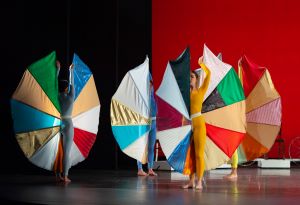The Greensboro Symphony Orchestra, led by Music Director Sitkovetsky, shed some weight Thursday night to fit into a guise of a much smaller Baroque orchestra, mostly strings, perfectly in keeping with performances by the giants of the first half of the 18th century — Bach, Handel and Vivaldi.
Bach wrote four orchestral suites, collections of stylized dances intended to be listened to, not danced. The GSO performed Suite No. 2 in B minor S. 1067, written for flute, strings and continuo. GSO first chair flutist Debra Reuter-Pivetta served as soloist, with Nancy Johnston at the harpsichord and Beth Vanderborgh on cello comprising the continuo.
The Overture begins with pompous, jerky rhythms, with first violins and flute doubling the melodic line. In the fast, imitative middle section, however, the flute breaks free and finds its own voice. Then begin the dances proper: Rondeau (a Gavotte), Sarabande, Bourrée, Polonaise, Menuet, etc. Each contrasts in character, tempo and mood, and each is in two parts, which were often repeated.
Some of the repeats featured new instrumentation, with the principal chairs acting as a string quartet with Reuter-Pivetta; this contrasting texture helped keep the piece fresh. In part of the Polonaise, only the flute and the continuo played, and each phrase ended with a big ritard — maybe not so stylistically correct, but certainly fun.
The finale movement, entitled “Badinerie” (which roughly translates “jesting”) is a tour-de-force for the flute, sort of an encore to the whole proceedings. Throughout the work Reuter-Pivetta displayed a lovely tone, long winded lines, and often tasteful ornaments. Special kudos go to both Vanderborgh and Johnston who provided a solid base throughout the evening.
Handel’s Water Music was written in 1717 at the bequest of King George I who needed some musical accompaniment for a party he was throwing on the River Thames. Handel knocked out a slew of movements for the occasion, which were later arranged into three giant suites. Thursday evening’s performance combined movements from the first and second. A couple of winds and brass added to the overall orchestral size and color.
Handel’s Overture is structured like Bach’s: a stately beginning and closing surround an animated middle section. The next seven movements vary in tempo and character, and one can get lost as to exactly where one is in the piece, because some movements have repeats and contrasting middle sections. But it doesn’t really matter, since this music was designed to be agreeable background music for the king’s party.
Frequently the oboe is singled out for some distinct work; other times the French horns (often conjuring up a hunt) and trumpets add some royal flair. The ensemble was good throughout, and some terrific dynamic contrasts were evident.
Vivaldi’s The Four Seasons is a collection of four violin concertos. The works are touted as some of the first pieces of “program music,” that is music that is inspired by extra-musical elements — in this case, poetry. Each of the four seasons “sets” the events and moods evoked in the accompanying sonnet. (In his opening comments, Sitkovetsky said the music was “like a soundtrack” to the poems.) A special treat was that the poems were read by (Chesley Kennedy) before each concerto was performed.
Sitkovetsky was center-stage, serving as both conductor and soloist. Sometimes only the GSO first chair string players (John Fadial, Fabrice Dharamraj, Scott Rawls, Beth Vanderborgh, and John P. Spuller) accompanied Sitkovetsky, giving the music a lean and intimate feel.
Sitkovetsky’s playing contained more theater than sometimes is present. But this music practically demands musical theater: shivering, icy string lines, gruff peasant fiddling. And the Maestro added ornaments not often heard in the piece. Great playing.












